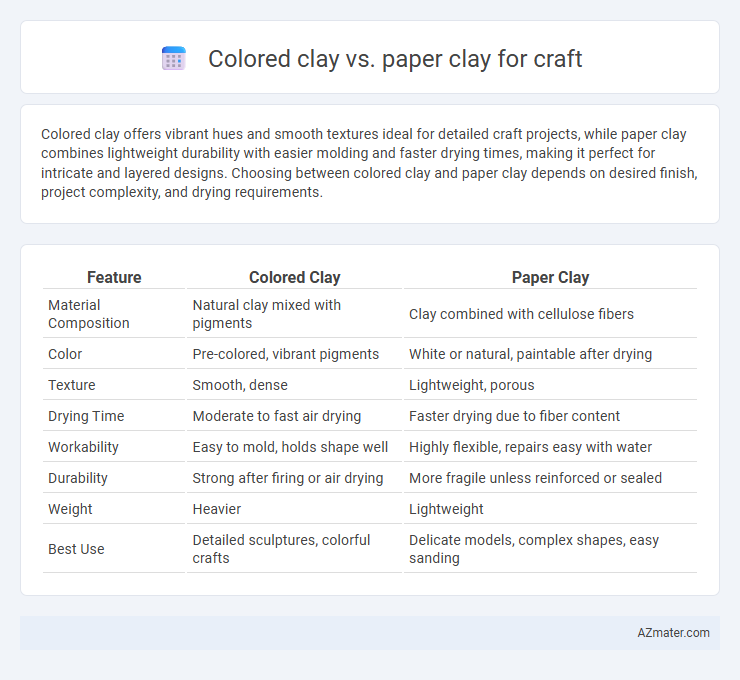Colored clay offers vibrant hues and smooth textures ideal for detailed craft projects, while paper clay combines lightweight durability with easier molding and faster drying times, making it perfect for intricate and layered designs. Choosing between colored clay and paper clay depends on desired finish, project complexity, and drying requirements.
Table of Comparison
| Feature | Colored Clay | Paper Clay |
|---|---|---|
| Material Composition | Natural clay mixed with pigments | Clay combined with cellulose fibers |
| Color | Pre-colored, vibrant pigments | White or natural, paintable after drying |
| Texture | Smooth, dense | Lightweight, porous |
| Drying Time | Moderate to fast air drying | Faster drying due to fiber content |
| Workability | Easy to mold, holds shape well | Highly flexible, repairs easy with water |
| Durability | Strong after firing or air drying | More fragile unless reinforced or sealed |
| Weight | Heavier | Lightweight |
| Best Use | Detailed sculptures, colorful crafts | Delicate models, complex shapes, easy sanding |
Introduction: Understanding Colored Clay and Paper Clay
Colored clay offers vibrant hues and is typically air-dry or oven-bake, making it ideal for detailed, colorful craft projects with a smooth finish. Paper clay incorporates cellulose fibers, enhancing strength and flexibility; it is lightweight and air-dries with a textured surface suited for sculpting and delicate work. Both materials serve distinct artistic purposes, with colored clay excelling in vivid color retention and paper clay favored for durability and ease of texturing.
Material Composition: What Sets Them Apart
Colored clay contains natural clay mixed with pigments, resulting in a pliable, earth-based material that hardens through air drying or firing. Paper clay incorporates cellulose fibers or shredded paper into the clay base, enhancing flexibility, reducing cracking, and allowing for thinner, lighter sculptures. The key distinction lies in paper clay's fiber content, which reinforces the material structure, whereas colored clay relies solely on mineral composition and pigment for its properties.
Workability and Texture Comparison
Colored clay offers smooth workability with a dense, pliable texture ideal for detailed sculpting and vibrant finished pieces, maintaining consistent color throughout the material. Paper clay, infused with paper fibers, provides a lighter, more malleable texture that dries faster and allows for delicate, thin constructions without cracking. Both clays respond well to water for softening, but colored clay excels in fine detail retention, while paper clay is preferred for airy, textured designs.
Color Options and Pigmentation
Colored clay offers a wide range of vibrant, consistent hues through pre-mixed pigmentation, ensuring even color distribution throughout the material for projects requiring uniformity. Paper clay, typically white or off-white, requires mixing with pigments or paints to achieve desired colors, providing greater customization but potentially less uniform coloration. The choice between colored clay and paper clay depends on whether artists prioritize convenience and color consistency or versatility and surface finishing options.
Drying Time and Shrinkage Differences
Colored clay typically dries faster than paper clay due to its denser composition, making it ideal for quick project turnarounds. Paper clay contains fibers that retain moisture longer, resulting in slower drying times and reducing the risk of cracking during drying. Shrinkage is generally less pronounced in paper clay because the cellulose fibers minimize contraction, whereas colored clay can experience more significant shrinkage and potential warping.
Strength and Durability Post-Drying
Colored clay typically offers higher strength and durability after drying due to its denser composition and integrated pigments, making it less prone to cracking or breaking. Paper clay, infused with cellulose fibers, enhances flexibility and reduces brittleness, which helps prevent fractures but results in a lighter, less rigid final product. Choosing between the two depends on whether the project requires robust structural integrity or lightweight, crack-resistant features.
Painting and Finishing Capabilities
Colored clay offers vibrant hues directly in the material, reducing the need for extensive painting, which suits projects demanding quick finishing and consistent color throughout. Paper clay, known for its lighter weight and porous texture, excels in accepting paints and finishes, enabling detailed surface treatments and smoother paint adhesion for intricate designs. Both clays provide distinct advantages: colored clay for color durability and paper clay for versatile finishing techniques and enhanced paint application.
Best Uses for Colored Clay in Crafting
Colored clay excels in crafting projects that require vibrant, ready-to-use hues without the need for painting, making it ideal for children's crafts, decorative figurines, and detailed jewelry designs. Its smooth texture and consistent pigmentation allow artists to create multicolored pieces with ease, enhancing the visual impact of sculptures and intricate art forms. Compared to paper clay, which offers lightweight and flexible properties for delicate models, colored clay provides richer color intensity and durability, perfect for lasting decorative items and tactile art projects.
Ideal Projects for Paper Clay Enthusiasts
Paper clay, enriched with cellulose fibers, offers enhanced flexibility and a lightweight texture ideal for intricate sculpting and delicate pottery. Its porous nature allows for easier sanding and surface manipulation, making it perfect for detailed figurines, mixed media crafts, and fine jewelry components where precision is key. Colored clay, while vibrant and ready-to-use, tends to be denser and better suited for robust projects like tile work or bold, minimalistic sculptures not requiring extensive surface finishing.
Choosing the Right Clay for Your Creative Needs
Colored clay offers vibrant hues and smooth texture, ideal for projects requiring immediate color and minimal finishing. Paper clay combines lightweight properties with added strength and flexibility, suited for intricate sculptures and delicate designs that benefit from air drying. Selecting between colored and paper clay depends on your project's color requirements, structural needs, and whether you prefer drying or firing techniques.

Infographic: Colored clay vs Paper clay for Craft
 azmater.com
azmater.com